Do you want to begin growing strawberries?
Have you been growing strawberries for a long time and simply want to get fresh ideas or helpful suggestions?
You’ve landed in the right spot! This site will teach you how to grow strawberries and get you growing strawberry plants in places you would have never dreamed possible.
We are passionate about everything related to strawberries here. We hope that passion shines through. Since the little and beautiful red berries are nutritious and delicious, we want to see more people develop a love for growing strawberry plants and eating the delicious and sweet strawberries they produce! In each garden strawberries have a place, and we want to help more gardeners find successful ways to incorporate them.
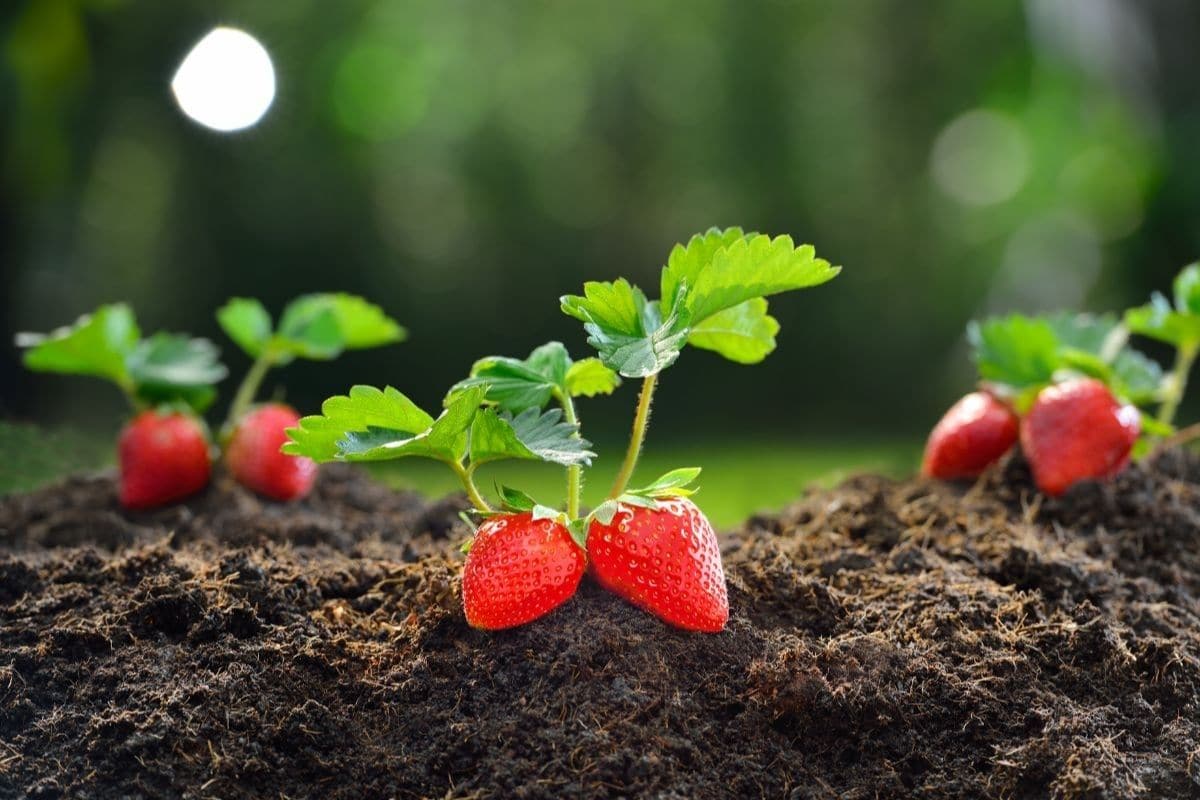
To help you navigate to the information that is most helpful for your present situation, use this handy-dandy table of contents to go directly to the information you need. If you want to start at the very beginning and work your way through, just scroll down!
How the Growing Strawberries Page Works
This main Growing Strawberries page serves as a hub for everything related to growing strawberry plants. The basics will be covered here. The information on this page should be sufficient to give any beginner the basics needed to be a successful strawberry gardener. However, when it comes to understanding how to grow strawberries, there is a never-ending wealth of information that can be assimilated for maximum production, aesthetics, and capacity in any garden.
So, while the basics of growing strawberries will be contained on this page, there will be regularly updated links to more pages on this site at the bottom that go into more detail about different methods and aspects of growing strawberry plants and how to grow strawberries using different methods. Be sure to take advantage of the links and resources as you grow strawberries in your own garden, whether it is for the home or for business.
Why Should You Consider Growing Strawberries?
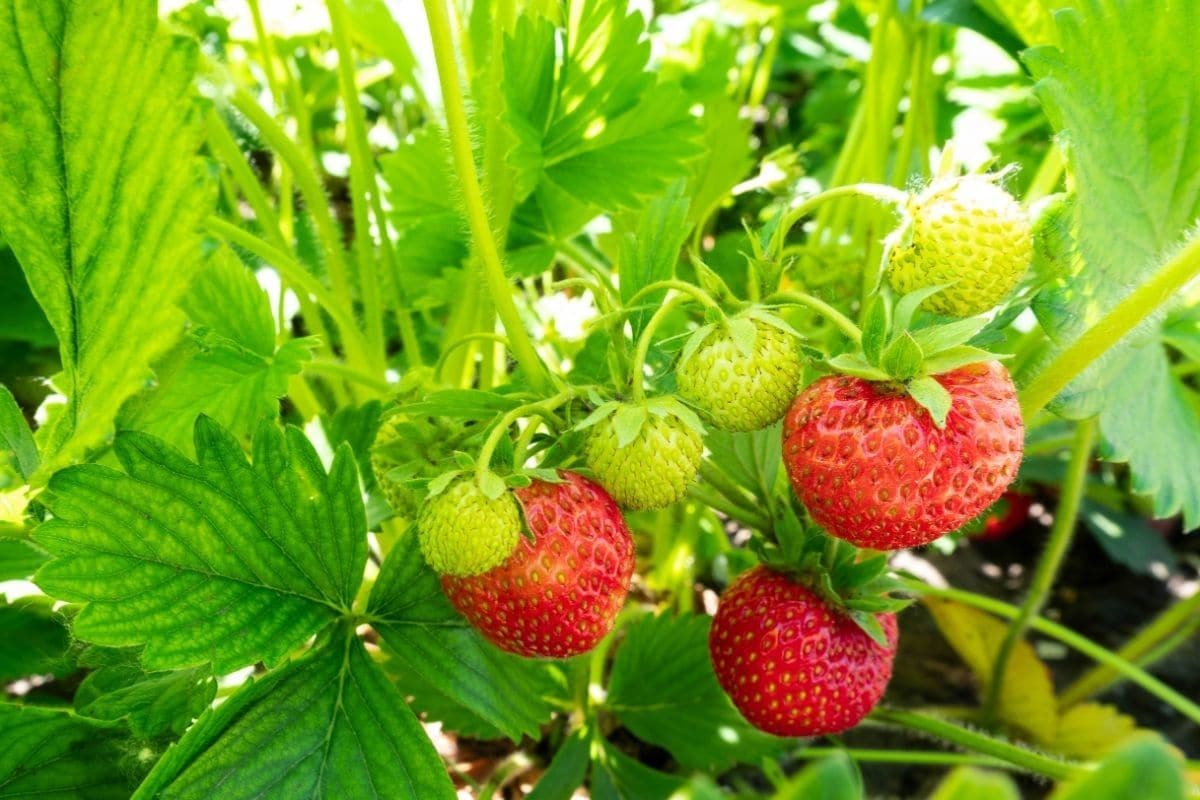
Strawberries are the most popular small fruit grown in home gardens for good reason. Few things bring back summer memories like sinking teeth into a fresh and juicy strawberry. Why not have these sweet berries growing in your own garden? They are able to be grown in all the temperate regions of the world!
Strawberries are relatively easy to grow, and they can fit within small space constraints or fill huge garden plots. Growing strawberries doesn’t require any specialized equipment. And, they can even be grown in a container or pot on a deck, porch, patio, or balcony.
One of the biggest benefits of growing strawberries is their perennial nature. You can reap the rewards of your labor for several years after initially planting strawberries with minimal effort after the initial planting year. With proper care, it is not uncommon for each strawberry plant to produce a full quart of strawberries. Approximately twenty-five strawberry plants should adequately supply a normal family with delicious strawberries.
Perhaps an even more important reason you should consider growing strawberries in your own garden is what you often buy along with the strawberries in stores. You buy pesticides. Commercial strawberries repeatedly rank very poorly on list of most-contaminated produce items (the Environmental Working Group’s data). This rank gains them membership in the infamous “Dirty Dozen” club. Even after washing, store-bought strawberries often have residual pesticides on or in them. Growing strawberries in your own garden allows you to know exactly what you are eating! In fact, here are reasons you should consider growing your own strawberries.
How to Grow Strawberries
Once you have decided to begin growing strawberries, you need to pick your starting point. You can grow strawberries from seeds, or you can opt to transplant or purchase strawberry plants for your garden.
It is more difficult if you start with strawberry seeds instead of existing strawberry plants. The Strawberry Seeds page will guide you through the delicate process of sprouting strawberry seeds and give you all the information you could possibly desire about strawberry seeds and where to find them. The Strawberry Plants for Sale page will point you in the right direction if you want to begin growing strawberries by purchasing existing plants.
Growing Strawberries from a Strawberry Plant
Whether you start with seed or plant, successful fruit production comes from successfully growing strawberry plants. All the factors and considerations needed for growing strawberries are: choosing your strawberry variety, selecting your planting site, deciding on a planting system, preparing your chosen planting site, planting the strawberry plants, creating a favorable environment, caring for the growing strawberries, harvesting the berries, renovating the berry beds, and preserving the strawberry plants throughout the dormant months.
The information below will cover everything you need to know to grow your own strawberries. Although the information is general, you should be able to apply it to any specific situation and find success.
Picking a Strawberry Plant Variety to Grow
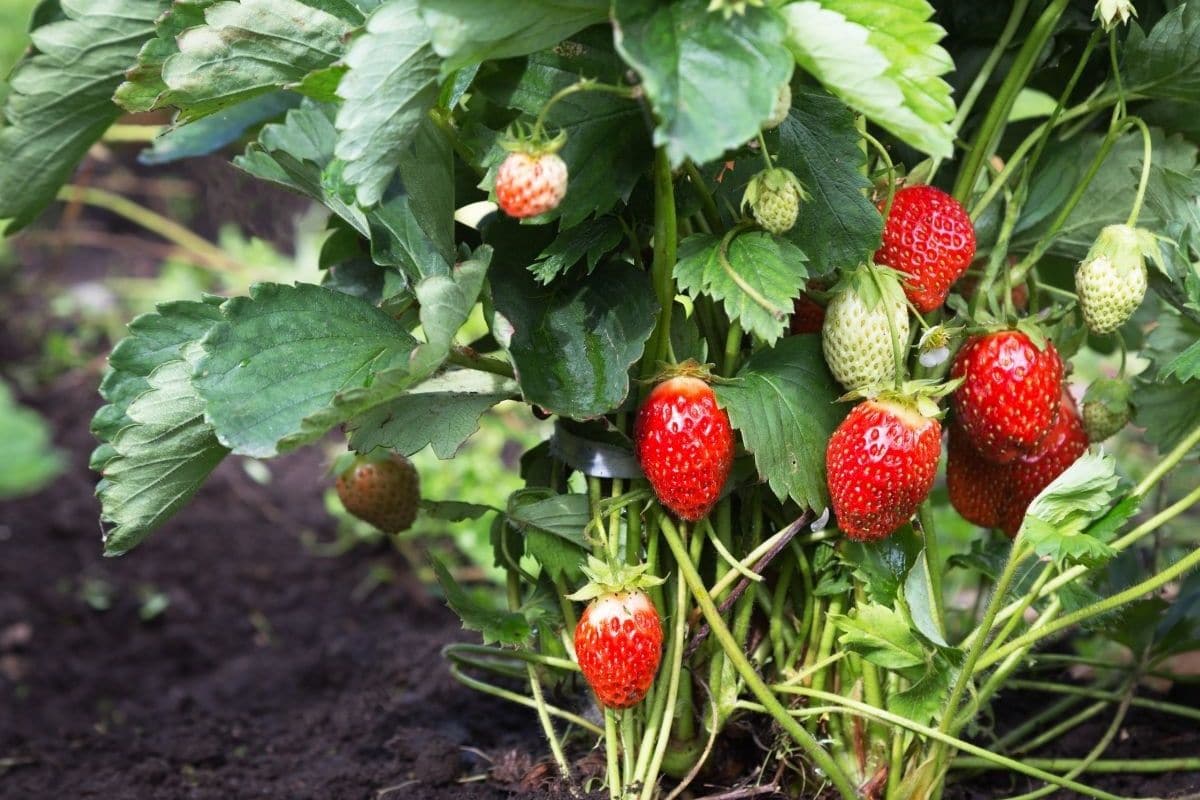
Before you begin growing strawberries in your garden, you need to determine which variety of strawberry plant you want to grow. To gain a deeper understanding of the types of strawberries and varieties of strawberries available to choose from, see our Strawberry Varieties page.
1. Pick Which Type of Strawberry
There are three main types of strawberries: June-bearing, everbearing, and day-neutral. Some people consider everbearing and day-neutral varieties to be the same thing, but they are actually different. For a full discussion of each, see the Strawberry Varieties reference page. In short, June-bearers have the largest fruit but only produce one big crop over a week or two. Everbearers produce a larger early crop, smaller late crop, and a few berries in between, while day-neutrals produce throughout the growing season. Everbearers and day-neutrals typically produce less and smaller berries overall than do the June-bearing varieties.
Considering these characteristics will determine which type is right for you. If you want fresh berries throughout the year and don’t mind picking smaller and fewer, go with a day-neutral or everbearing variety. If you want sheer quantity of berries, go with a June-bearer (what most people do).
Read our Guide on Growing Everbearing Strawberries.
Considerations on how you plan to use your strawberries also come into play when determining which type to buy and plant. If you want to can or preserve your harvest, it is easiest to accomplish your goals with the larger size and quantity that come from June-bearing strawberries.
2. Pick the Right Variety
Not all strawberry varieties are created equally. Strawberries are temperate by nature and can be finicky as to what makes them happy. So, thanks to decades of dedicated breeding programs, scores of specialized strawberry varieties have been developed and released. The most generally-adapted cultivars have become quite popular, but the popular varieties might not be the best choice for your location. To help you find which variety is suitable for your state/location, I have gathered the recommendations by state Extensions and compiled them in one place. To be sure you get an appropriate variety, check the recommended varieties for your area and choose one suitable to your locale.
You may also want to extend your growing season by choosing early-, mid-, and late-season varieties. Doing so can extend your harvesting period as follows:

And, if you have garden space, you might want to consider growing some novelty or specialty strawberries. Pineberries are the latest to spark wide-spread interest due to their white color, red seeds, and pineapple taste. Also, this season is also expected to be the first prominent one for the brand-new Purple Strawberries (not-GMO). And, absolutely no strawberry variety tops the classic and diminutive Alpine varieties for sheer taste and aroma for specialty and gourmet recipes. The possibilities are almost endless!
If you are completely at a loss for where to start, you can always call your local Cooperative Extension and ask them for recommendations. They can give you more specific information on which strawberries grow well in your area. As new and improved strawberry cultivars are also introduced each year, your Cooperative Extension can also clue you in to any new developments or local suppliers where you can find a good cultivar for your area. Or, if you don’t want to call your state extension, you can review state by state recommendations here: Recommended Strawberry Varieties by State.
Another factor to consider when picking a strawberry plant variety is susceptibility to Verticillium fungus. This fungus causes the most common strawberry disease, Verticillium wilt (or Verticillium rot), which will end fruit production by killing growing strawberries. Since there is no practical way to kill the fungus once infection sets in, this prevalent disease is best prevented by obtaining and planting strawberry plant varieties that are certified to be resistant to Verticillium wilt.
Once you settle on growing a strawberry plant variety, you need to get your plants. There are numerous catalogs and nurseries from which you can buy certified, healthy plants. With the proliferation of online suppliers, getting specific strawberry plants to grow has never been easier!
Learn more from our “When is Strawberry Season?” article.
Pick the Right Quantity to Order
Part of learning how to grow strawberries is picking the right amount of plants to begin your patch. Thinking through your goals and planned uses for your berries will guide your ordering/buying. If you buy too many, you might be overwhelmed. If you buy too few, you might be frustrated with the lack of berries when you need them. Before you order, be sure to think about and study up on what you are going to need. These resources should give you the information you need: How Many Strawberry Plants per Person, How Many Strawberries do Strawberry Plants Produce, and Strawberries per Day.
Buy the Strawberry Plants / Seeds
Once you have settled on the type, variety, and quantity of strawberry plants, all that is left is to get the best possible deal on plants. We’ve made it as easy for you as it can possibly be. Just go to the Buy Strawberry Plants or Buy Strawberry Seeds page, find the variety you would like to order and take a look at the listed stores to see which one offers you the best deal. If you’d rather buy from a bricks-and-mortar establishment or nursery, see our directory of local Strawberry Nurseries.
Choosing Where to Grow Strawberries
Choosing an area conducive to growing strawberries is a critical step in learning how to grow strawberries. There are several factors that need to be considered when selecting a site for your strawberry garden.
First, strawberries love sunlight and need full sun to produce the largest yields. While harvestable berries will be produced with as little as six hours of direct sun a day, it is best to select a site that is clear of other tall or shadow-casting trees or plants. Planting strawberries away from large trees is important so that the tree root system doesn’t compete with and siphon away needed moisture from the growing strawberry plants.
Second, there are several soil issues that should be addressed. While they are able to be grown in most soil conditions, strawberries prefer a sandy loam that is deep and contains very high amounts of organic matter. Extra compost, peat moss, and some sand or grit can be added to your selected site to create the best environment for growing strawberries. Potting soils usually have sufficient compositions if you are planning on planting strawberries in a container. In that case, add an extra inch or two of fresh compost to the surface of the potting mix.
The history of the dirt patch is also important to your success in growing strawberries. If other Verticillium-susceptible crops have been grown in the same area during the last three years, it is best to choose a different site. The most common of these plants are tomatoes, potatoes, eggplant, peppers, and strawberries. If these plants (or melons, okra, mint, bush or bramble fruits, stone fruits, chrysanthemums, and roses) have been grown in the same spot recently (within 5 years), it is best to grow your strawberry plants elsewhere.
Third, it is important to pick a site that has good soil drainage and surface drainage. Although strawberry plants need constant moisture to thrive, the plants will rot if left in standing water due to poor site drainage. If you only have access to a site that has poor drainage or heavy soils, constructing a raised bed for the strawberry plants should facilitate better drainage. The strawberry bed should be elevated, at minimum, six to eight inches. Also, make sure there are drainage holes in the bottom if you are using container gardening methods.
Strawberries do not perform well in drought conditions either. Therefore, be sure to select a site that will allow easy access so that it can be watered if rainfall is not adequate.
You can also grow strawberries inside (hydroponics). Good system for indoor growing is called The Dutch Bucket Hydroponics System.
Planting Systems for Growing Strawberries
When growing strawberries, it is important to keep in mind that they are traditionally grown as perennials. So, even though some varieties can be grown as annuals in the hotter parts of the south, better results are usually obtained when the strawberry plants are planted in one year and nurtured for bigger yields in subsequent years. Various planting systems are used for growing strawberries depending on which type you plant.
As discussed in the Strawberry Varieties page, the three types of strawberries are June-bearing strawberries, ever-bearing strawberries, and day-neutral strawberries.
June bearing strawberry plants are most often planted using the matted row system while day neutral strawberry plants and ever-bearing strawberry plants are usually planted in a hill system (also called the mound or mounding system). These two systems usually yield the best crops. However, spaced row systems, single hedgerow systems, and double hedgerow systems are also used.
The Matted Row System:
The matted row system for growing strawberries is most commonly used for June bearing varieties, and it works well for any cultivar that sends out a lot of runners. To grow strawberries with this system, set plants about 24 inches apart (18 to 30 inches is acceptable) in rows about 4 feet apart. Allow runners to spread freely and root at will within the row to form a crisscrossed, matted row about 24 inches wide.
The matted row system of growing strawberries will produce the largest number of strawberries, but the quality of individual berries is rarely equal to the quality of berries grown with the hill system. Here is a diagram of how to use the matted row system to grow strawberries:
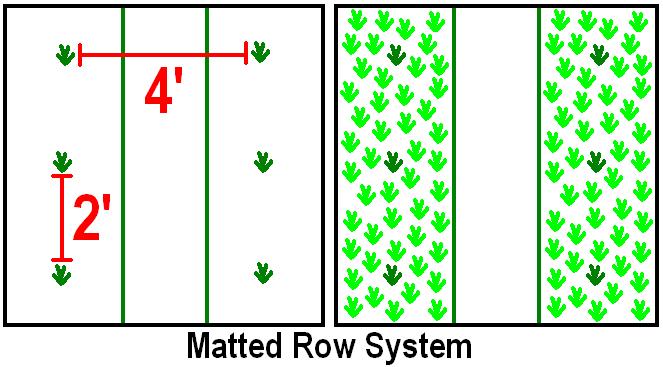
The Hill System (also known as the Mound System):
The hill system for growing strawberries is most commonly used for day neutral strawberries and everbearing strawberries. To grow strawberries with this system, you start with a mounded “hill” of soil about 8 inches high and 24 inches across. Extend this mound into a row as long as you like. Set two rows of plants per hill in a staggered pattern with each plant being 12 inches from the other plants. Multiple rows are spaced 4 feet apart.
All runners are removed from every strawberry plant in the hill system as soon as they are identified. Removing the runners causes all the productive capacity of the mother plants to remain with the mother plants. This energy will result in additional lateral crowns adjacent to the original crown and more flower stalks for fruiting. The hill system is often preferred by the home gardener because it results in a higher quantity of higher quality berries (fancier, larger, better for selling at farmers’ markets), while the matted row system usually produces a higher total number of strawberries.
There are two modified versions of the hill system: the single hedgerow and the double hedgerow (also called the spaced-row system). These systems are the same as the hill system except that some runners are permitted. In the single hedgerow system, each strawberry plant is allowed to root two additional runner plants. The double hedgerow permits several runners to root. All runner plants in this system should be spaced at least 4 inches away from other plants (5 to 7 inches is better).

Preparing Your Garden for Planting Strawberries
Once you have decided where you will be growing strawberries, you need to prepare your garden for planting strawberries. If your site is sod-covered, it is best to cultivate and till the area the year before you want to plant your strawberries to eliminate competing grasses. When possible, it is best to grow a green manure crop the year before you want to begin growing strawberries to improve soil quality (oats, sudan grass, and rye are all excellent for this).
When you are ready to plant your berry plants, you should, to the best of your ability, ensure that the site is free of weeds, grubs, and any soil-borne diseases. Once any sod or grass is gone, work two to three inches of compost into the top layer of soil. Add more organic material before planting, especially if the soil doesn’t retain moisture very well. Peat, compost, or aged straw and manure are good options. Additionally, organic or inorganic fertilizer can further improve soil quality by being worked down to six inches.
The pH of your site’s soil is also important for growing strawberries. In order to grow strawberries most effectively, the soil needs to be slightly acidic. Strawberry plants will grow in dirt that has a pH between 5.0 and 7.0, but 5.8 to 6.2 is ideal for maximum growth and production. Soil test kits are available online and through garden supply stores. However, the best results are obtained through the professional soil testing services provided by your county’s agricultural extension agent. Before planting strawberries, you should test your soil and amend it as indicated to create the best possible environment for growing strawberries.
Common amendments are lime and manure. If test results show that lime is needed, it should be applied prior to planting the strawberry plants and tilled in thoroughly with the soil. Compost or aged manure from cows or horses is also added, usually at a rate of 2 to 5 bushels per 100 square feet.
Planting Strawberry Plants
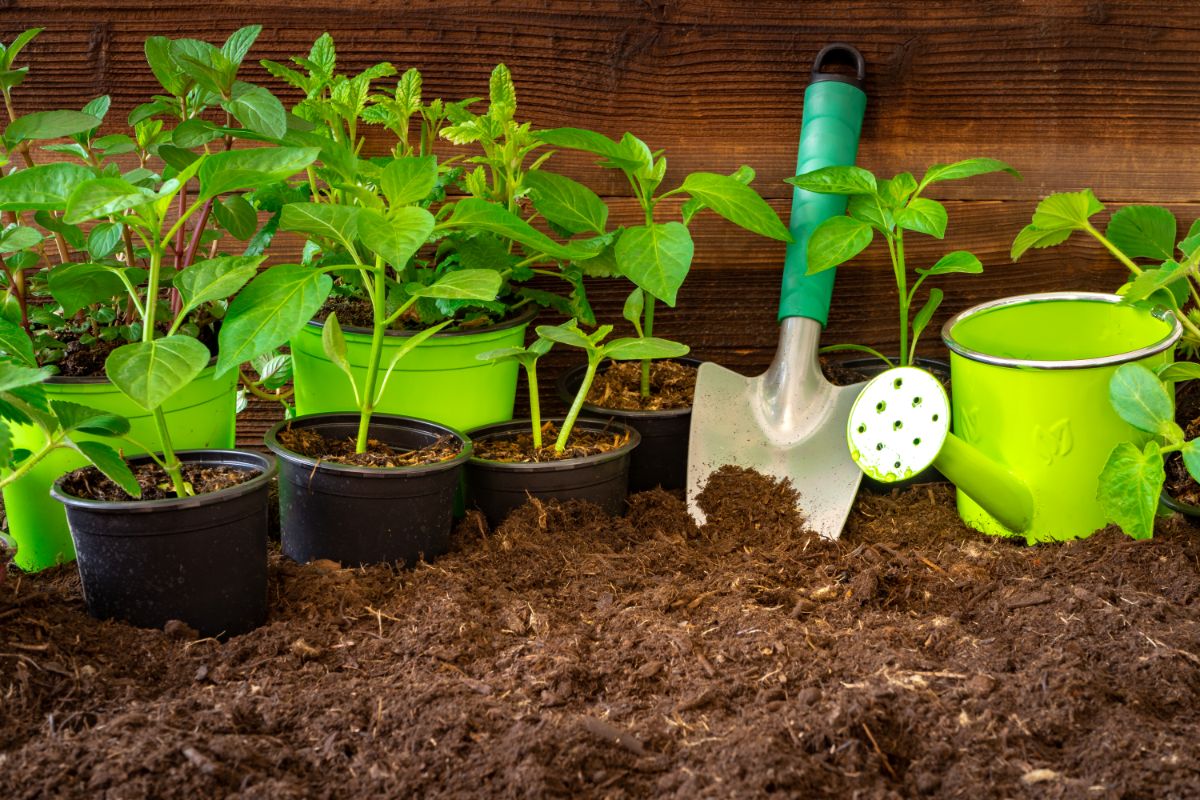
Learning how and when to properly plant strawberries is an important step in learning how to grow strawberries. Fortunately, it is fairly easy! This guide is tailored to the typical home gardener who plants an entire garden, including strawberry plants, in the spring. For gardeners who don’t mind planning a bit, planting fall strawberry plants can be a better option if harvesting during the first growing season is important!
For spring planting, as soon as the soil is dry and able to be worked (usually March or April), you should plant your strawberries. The plants need to be well-established before the temperatures rise in the summer months. When you are ready, loosen and pulverize the dirt down six to eight inches, and keep it loose to allow runners to take hold and roots to establish.
You should have disease-free, healthy plants ready to plant. If picking them yourself, choose plants that have large crowns with healthy, light-colored roots. If you ordered them, open the package immediately and inspect them. If moldy, send the strawberry plants directly back. If you can’t plant them immediately, wrap the strawberry plants in wet paper towels, put them in a bag, and store them in your refrigerator until you can plant strawberry plants outside. Planting strawberry plants should be done on a cloudy or overcast day or during the late afternoon.
How to plant strawberries: dig out a hole big enough to spread out the roots of each strawberry plant. In the bottom of the hole, create a mound or hill of soil that is flush with the surrounding soil level. Put the strawberry plant on top of the hill inside the hole so that the crown is at soil level and spread the roots out down the sides of the hill. Fill in the hole and ensure that the soil level is even with the middle of the crown. Planting too shallow may cause the roots to dry out before they establish, and planting too deep can also damage growing strawberries. See the figure below for proper crown placement. Once the plants are planted, press to firm the soil around the roots and then water thoroughly.
There are two main scenarios gardeners typically encounter when deciding to order plants. They either obtain plants that are actively growing (either in pots or as plug plants), or they buy dormant bare root strawberries. The potted plants usually have a head start on the dormant plants and will grow more quickly, but they are typically significantly more expensive. For the same price as two or three potted plants, one can often obtain 20-25 bare root plants. Plug plants are in the middle of the cost spectrum, but they are still usually more expensive than the bare root strawberries. Planting each is slightly different.
Secondly, here is a video demonstration of how to plant bare root strawberry plants. Again, the video was produced by the Gardener’s Supply brand, but it is also representative of how to plant any bare root strawberry plant from any reputable source.
Creating a Good Environment for Growing Strawberries
Once the plants are in the ground, it is important to create an environment that is most conducive to growing strawberries. Mulching is a time-honored method for making the growing strawberries happy.
After you’ve planted your strawberry plants, mulch the strawberry bed with shredded leaves, pine needles, compost, or straw. Pine needles are a good choice as they slightly raise the acidity of soil as they decompose. Mulching also keeps the soil temperature down, mitigates the weed problem, and keeps the fruit cleaner by keeping the strawberries off of the dirt. Most varieties of strawberries produce better when their roots are in cooler soil.
Different Strawberry Types Need Specific Care Regimens
If you have decided to grow strawberry plants, you probably don’t want to wait to reap the fruits of your labor. I don’t blame you. However, delaying gratification now can result in higher quantities of strawberries later. Additionally, it is important to treat June-bearing strawberries differently than everbearing strawberries and day-neutral strawberries.
All types of strawberry plants will produce better in subsequent years if all their energies are devoted to establishing themselves and producing healthy runner plants in the first year. To accomplish this requires a feat of delayed gratification. To have the strongest plants in subsequent years, you have to remove all the flower buds in year one. Without flower buds, you won’t be able to enjoy harvesting strawberries. But, you’ll get more and better berries beginning in year two. Few people do this, but most should.
For June bearing varieties, you can train the runners to follow a specific pattern, or you can allow them relative freedom in a matted row system. In general, all strawberry plants will produce best when limited to a density of approximately five plants per square foot. Too many strawberry plants will have the same effect as weeds would: reduced yields of smaller strawberries. Of course, any and all weeds should be removed.
For day neutral and everbearing strawberry plants, the removal of buds and runners should occur until July 1st of year one. They naturally don’t put out as many runners as June-bearers. Instead, they focus their energy on producing multiple strawberry harvests. You may end up getting a small harvest with everbearing or day-neutral varieties, depending on your climate.
The main harvest will come in the second year when all mother plants and all the runners which were well-rooted before August will produce strawberries!
Water Requirements for Growing Strawberries
Growing strawberry plants require a constantly moist environment, so regular watering is needed. To have the most success growing strawberries, at least an inch of water should be provided to the plants either through rainfall or direct supplemental. Up to two inches of water can be given while the fruit is forming, from early bloom until the end of harvest. Watering should continue during dry periods in August and September. This later water helps reduce stress on the strawberry plants which helps fruit bud formation in the following year.
Remember, while water is critically important when growing strawberries, they do not like to sit in standing water. This is why your site needs good drainage. Strawberry plants are relatively shallow-rooted, so soggy ground can cause them to rot while dry ground can kill them or stop fruit production. Mulching helps keep the moisture level of your soil more consistent.
Learn more about watering strawberry plants.
Fertilizing Strawberry Plants
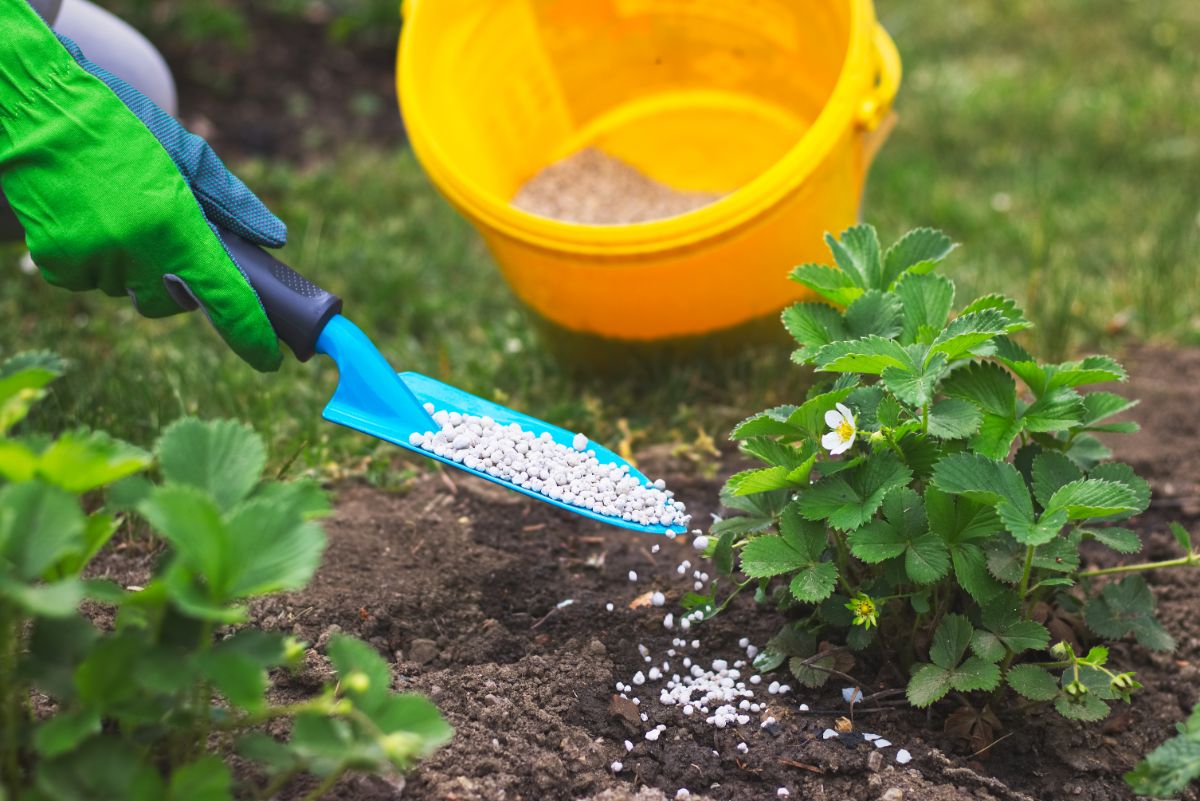
Fertilizing helps growing strawberry plants reach their maximum potential. It can be beneficial to fertilize multiple different times in the life of a strawberry bed.
First, a balanced (10-10-10) fertilizer should be added just before planting your strawberry plants. Add one to two pounds of fertilizer per 100 square feet. This helps increase the nitrogen levels in the soil.
Second, during the first year of the strawberry garden, another round can be applied after the strawberries have been planted for around four to six weeks, and again in August, depending on plant growth.
Third, day-neutral and everbearing strawberries can be fertilized after the first harvest. June-bearing strawberries should be fertilized during renovation. This is done to keep the plants vigorous. Be sure to water the fertilizer well to get it to soak in down to the roots of the growing strawberries.
You should not fertilize your strawberry plants in the spring of a fruiting year. Too much nitrogen will result in soft, easily-damaged strawberries. You can still fertilize after the initial crop for day-neutral and everbearing strawberries, and you should also fertilize immediately after renovation once the plants are completely dry. Applying fertilizer to wet strawberry plants can result in phytotoxicity, and no fertilizer particles should remain lodged in the plants. After application, sweep your plants with a broom or other suitable tool to dislodge any stuck fertilizer.
You do have to be careful when fertilizing growing strawberries. If you apply too much fertilizer, you will get excessive leaf growth and poor production of flower stalks. If you plant strawberries in colder climates, late-season fertilizing can cause new growth that will be damaged by cold-weather frosts. Indeed, I have grown strawberries without any fertilizers in less-than-optimum soil and still gotten a reasonable harvest, so it is better to fertilize too little than too much until you become experienced.
If you prefer growing organic strawberries, blood meal can be used to increase nitrogen while bone meal can be used to increase phosphates. Growing organic strawberries with these organic fertilizers requires application about once per month from June through September.
Learn more about fertilization and nutrients for strawberry plants.
Protecting Your Growing Strawberries
Humans aren’t the only creatures that like the tasty, sweet strawberries you will be growing. Birds and slugs (and other critters) love them too. Birds will inevitably get some of your strawberries. However, you can protect the vast majority of them by covering your rows with bird netting. Additionally, copper ribbon will keep the slugs away.
Learn more about keeping birds, bugs, and other pests away from your strawberries.
You Grow Strawberries for the Harvest!
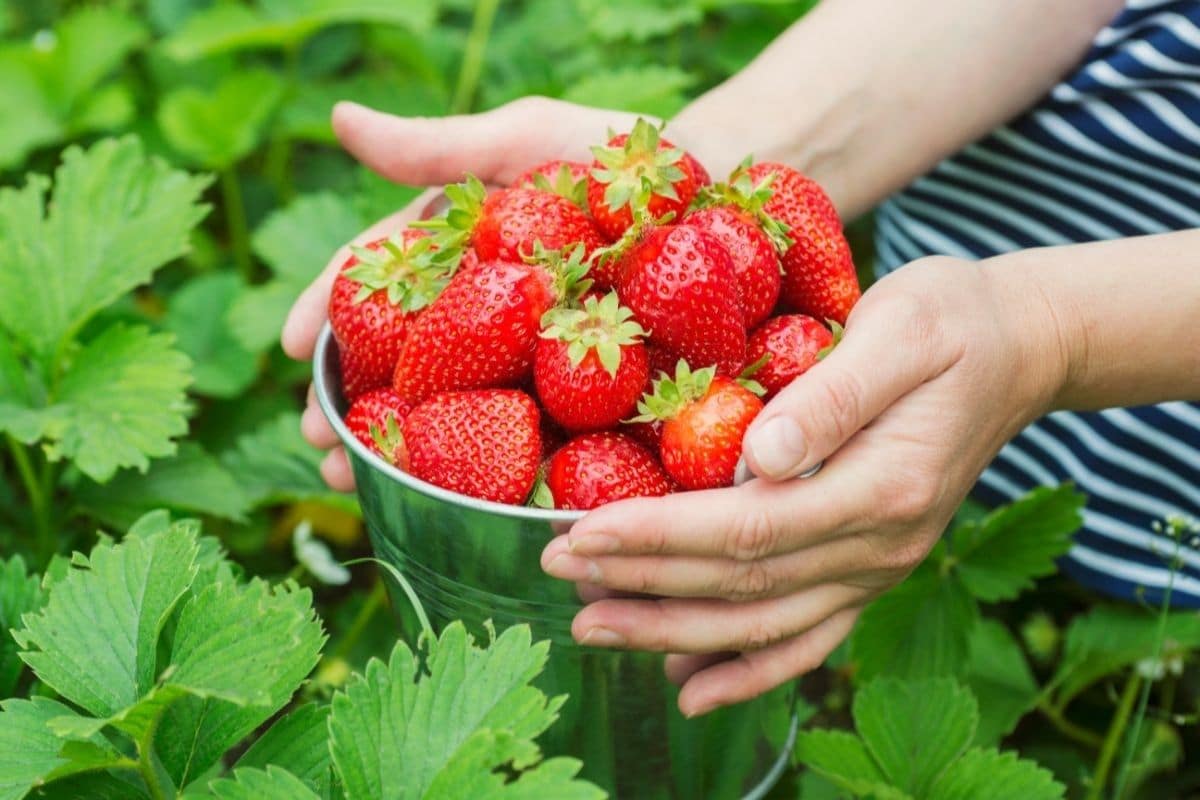
After a couple of years planting and caring for growing strawberries, you are ready for harvest! Strawberries should be completely ripened on the plant before harvesting. Most varieties should be left on the plant for one or two days after the strawberries have gained full color. Ultimately, however, you have to eat one to know if it is ready!
Strawberries are somewhat fragile and are easily damaged and bruised. Gentle hands and tender care should be used when picking them from the strawberry plants. To pick a ripe strawberry, release it using the fingernails of your thumb and forefinger to sever the stem directly above the berry instead of pulling on the strawberry itself. Cradle the berry in your palm as you pick it so that it doesn’t fall and bruise or get dirty. The cap and part of the stem should still be attached to the berry. You can harvest your strawberries as often as every other day if you want to maintain ripe, high-quality fruits.
Strawberries should be dry when they are picked. Wet berries do not do well and will mold quickly, and, unlike tomatoes, will not ripen after being picked. As soon as they are harvested, it is best to place unwashed strawberries in a cool, dry, shady place (a refrigerator is best). For more information and a ripeness chart, see the Strawberry Picking page.
Preserve or Use Your Strawberries
Like most garden plants, strawberries produce in season. While the seasons vary, it is difficult to keep a plant producing all year (and, it is hard on the plants!). So, taking the harvest and preserving them for future use makes a lot of sense. Whether they are jammed, jellied, dried, or saved in some other form, most people love Strawberry Preserves. If you don’t have a traditional family recipe for strawberry preserves, feel free to use any of those! Or, if you prefer more Fragaria delightfulness at a lower temperature, try one of the 8 main methods of Freezing Strawberries to preserve your harvest. And, of course, be sure to use as many as you can in delicious Strawberry Recipes!
Strawberry Garden Renovation
Renovation is an important part of growing strawberries of the June-bearing variety in the matted row system. Since strawberry plants don’t live forever, renovating right after harvest can keep them vigorous for up to five years as new runner plants are given the chance to replace old or weakened plants.
To renovate, thin the plants in the rows to about 6 inches apart (5 to 6 plants per square foot is the maximum acceptable). Then, mow the tops of the plants to one inch above the crowns. Take special care not to damage the crowns. If the foliage is disease-free, rake the leaves and compost them or incorporate them into the soil. Fertilize with a balanced (10-10-10) fertilizer. Narrow the rows to between 12 and 18 inches by hoeing or tilling.
A good, aggressive renovation effort will see about half of the strawberry plants removed. After plant removal, work the mulch medium into the soil with a tiller. Since strawberries have a shallow root system, spreading a thin layer of soil (about a half inch) around the crowns can help facilitate new root development. Continue to water the plants at least 1 inch per week through September and maintain the planting as weed-free until the first frosts. Allow early runner plants to root where they will until your desired row width is re-established. However, runners produced after September 1st will not have time to establish themselves and survive the winter, so they can be removed.
Whenever you begin to notice the growing strawberries losing vigor or struggling to maintain their vitality, or if your yields begin to decrease, you may have reached the end of your strawberry bed’s lifetime. When this occurs, start over with new plants in a new area. Click this link for a detailed explanation: Strawberry Renovation.
How to Grow Strawberries in the Second Year? Keep Them Alive!
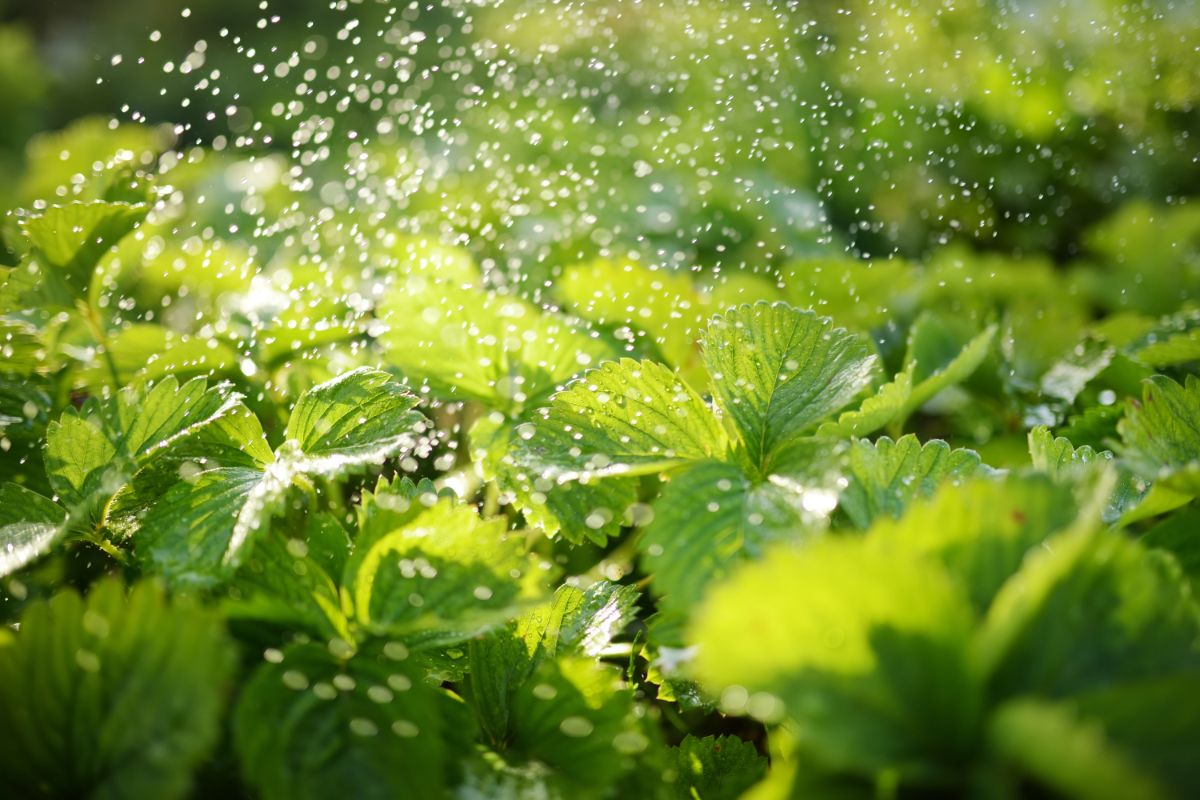
If you want to continue growing strawberries from year to year, you have to preserve the bed and the strawberry plants in it. In areas with relatively warmer winters, your strawberries will likely not need much additional care to survive the winter. In colder climates additional mulching is required when the temperature drops into the twenties, but before it falls to 20 degrees Fahrenheit. Strawberry blossoms, however, are easily damaged by frost and will have to be protected in the spring if frosts are predicted.
For cold winters, wait until the strawberry plants go dormant. This usually happens in December when temperatures drop into the teens or low twenties and the top half inch of soil is frozen. Then, apply a mulch of straw or pine needles 2 to 3 inches thick over the bed. Other mulches that do not contain weed seeds can be substituted in a pinch, but do not use sawdust, leaves, or cut grass as they will pack too tightly and can smother the plants.
Watering the mulch lightly can help prevent wind loss. Additionally, don’t apply mulch after several consecutive warm days. The mulch may spur the strawberry plants to begin growing again which will result in extensive temperature damage and even plant loss.
In the spring, rake the mulch off to the side so that the plants can begin growing again. However, keep it handy so that the plants can be recovered when frosts are predicted. Old blankets or cloths or commercial materials like Reemay can be used to mitigate the threat of frosts as well. Leave the mulch around the base of the plants to keep the berries off the ground also.
Learn more on growing strawberries in cold weather.
Growing Strawberries: Conclusion
Strawberries are one of the most rewarding food crops to grow in a small home garden. Homegrown berries taste far better than the store-bought ones and you can save some serious money by not having to pay supermarket prices.
Be sure to check back often for updated articles on the various aspects of successfully growing strawberries in different environments and with different methods!
More:
Growing Strawberries in Containers
Have you tried growing strawberries in containers or pots before and found only failure? Growing strawberries in containers can be frustrating, but it doesn’t have to be. Follow these 6 tips and your container strawberries will produce like champs!
What Causes Small Strawberries?
What causes small strawberries? The most common causes of small strawberries are discussed here. The first step to fix a problem is knowing what the root causes are.
Strawberry Pollination
Strawberry pollination is not very difficult. However, pollinating strawberries has some surprising benefits. Learn why and how to pollinate strawberries. The benefits are multitudinous!
4 Secrets to Growing Loads of Organic Strawberries
If you want to find success growing organic strawberries, these 4 secrets will help you grow organic strawberry plants with maximum efficiency and highest yield!
Planting Strawberries in the Fall
Fall is the best time to plant strawberries for several reasons. The most important, however, is so that you do not have to pinch or snip the flowers off of your spring-planted strawberries. Yay for 1st-year harvests!
Wilting Strawberry Plants
Do you have wilting strawberry plants? Why do strawberry plants wilt? If you want to know what causes strawberries to wilt and what causes wilting strawberries, be sure to review the information in this post.
Mulching Strawberry Plants with Straw for Winter
This step-by-step guide is about mulching strawberry plants with straw for winter. Take these steps to mulching your strawberry bed and see your strawberry plants safely through the cold.
Overwintering Strawberries
Want to know how to overwinter strawberries in containers? Overwintering strawberry plants doesn’t need to be hard or confusing. Learn everything you need to know about overwintering strawberries here.
Strawberry Seedlings
Learn about newborn strawberry plants here: planting strawberry seedlings, handling strawberry seedlings, hardening strawberry seedlings, and everything about the strawberry seedling!
How Many Strawberries Do Strawberry Plants Produce?
Find out all you need to know about the quantities of strawberries you can expect to harvest: by plant, by row foot, or by acre. Use this info to plan ahead for your needs!
Strawberry Planting Guide
Use this strawberry planting guide when planting strawberries to know exactly when to plant strawberry plants in your area. Date ranges for zones 3 through 10 provided here.
Companion Planting Strawberries
Learn about companion planting strawberries and which companion plants work well for strawberry plants. Lots of information on strawberry companion plants and companion planting is here.
Growing Strawberry Plants Commercially
Growing strawberry plants commercially can be profitable. But, commercial strawberry growing isn’t easy. Read this before trying to grow strawberries commercially.
Strawberry Plants and Cold Injury
With strawberry plants and cold injury threat events, checking strawberry plants for cold damage is needed. Dormant strawberry plants revive with warmer weather and can get damaged when temperatures drop. Here’s how to do it.
Strawberry Plants Producing Runners but no Strawberries?
Few things are as frustrating as seeing strawberry plants grow well and then be stingy with the strawberries. No strawberries on strawberry plants is a very sad sight. Here is how to fix strawberry plants producing runners but no strawberries.
Strawberry Flowers
Each strawberry flower turns into a strawberry. Here we discuss where strawberry flowers come from, strawberry flower care, & other info on strawberry flowers.
Monthly Growing Strawberries Guide
This growing strawberries guide is a great monthly strawberry growing overview. It covers the main tasks that need to be attended to each month and season.
Transplanting Strawberries
Ever wonder when to transplant strawberry plants? Transplanting strawberries is not too hard. Here is how you should go about transplanting strawberry plants.
Strawberry Plant Propagation
Strawberry plant propagation doesn’t have to be hard. There are three main ways to propagate strawberry plants. One is the easy way to propagate strawberries.
Strawberry Plant Runners
What are strawberry runners? The details of strawberry plant runners are here. Find out the benefits, drawbacks, & usefulness of runners on a strawberry plant.
Strawberry Plant Diseases
Strawberry diseases can affect fruit, flowers, leaves, roots, and crowns of strawberry plants, and sometimes cause the collapse of the whole plant. Learn about bacteria, fungi, molds and viruses.
Avoiding Birds, Bugs, and Other Pests
In this article we will give you some simple suggestions for letting our animal friends find other sources of sustenance and keeping your strawberries for yourself.










Stathis Papavasiliou says
Simply outstanding !!
Thank you
chris says
i love strawberries
I would like to rwmove some leaves but don’t want to stress the plants. It’s 85 F for the highs and Florida humidity,
Susmitha Sundararajan says
Hey,
Your article is too good for growing strawberries. I have also added a brief description about the process of strawberry farming guide. Please check by clicking here – Strawberry Farming
Lucas says
Is there supposed to be old black stuff + clovers In a strawberry plant after 1 season???
VVeerapen says
I live in the Southern Hemisphere (June here is a winter month). How does that affect the harvest of June-bearing, everbearing, and day-neutral compared to the Northern Hemisphere ?
Leanne Heidinger says
I live in South Dakota and am looking to start a strawberry bed. I’m thinking of using wooden pallets. Are there any pitfalls I should be aware of using wooden pallets?
Jim Nichnadowicz says
I am really impressed with this site. Not only is the information spot on but your sources are up to date and contain some of the best nurseries in our area. You really did your homework. Thank you – oh, is there a way to buy your book without using paypal ? Sincerely, Jim N.
Mr. Strawberry says
Thanks for the kind words. Sorry but at the moment PayPal is the only option.
Emily says
I have bought a strawberry plant from a garden center…it is still in the pot, and has some runners coming off of it. According to the label thing stuck in the soil, they are called raspy berry strawberries. I have no idea which of the 3 varieties it is. I live in Canada and would like to know if I should transplant to a spot in my garden, and if I should fertilize, considering it’s almost the end of July. I have nothing else growing in my garden right now, as the soil is not prepared for anything. Thank you!
Apostolos says
So….
In a fruiting year we do not fertilize in the spring.
However I remember reading somewhere in this website that when the first strawberries appear we start giving some kind of fertilizer (I do not remember NPK) every two weeks.
Did I get something wrong?
sunil sharma says
I planted many plants of strawberries in my front yard, they get enough sunshine (at least 6 hours) and continuing with water. The fruit also came in the plant but was quite small, they became distorted when they were mature. Can you tell me how it happened?
Kerry Nelson says
We have had our strawberries in raised beds for two years…with overhead sprinkling…the plants look healthy…not sure the variety but they are everberring….the problem is the berries are very mushy…just wondering if it’s the type of variety and should we just dig up and start over with new variety.? Or what causes mushy berries? Thanks for your help. We live in Eastern Washington.
James Morrell says
Hi. Love this site! I do have a question though. I being a dumbass bought the Blue Strawberry seeds for 10 bucks.
I germinated about a 100 of them and so far in 3 weeks have 46 thriving little ones going. My plan is to grow them in pots indoors year round. Any great advice on this would be very much apreciated.
Thanks to everyone out there who leaves their knowledge as well.
Jim
Mr. Strawberry says
James,
Please share this with your friends and family! Then, follow the instructions on this page as closely as possible with your plants being indoors! Good luck!
Larry Reed says
I have a great crop of plants but don’t have much fruit. Any suggestions?
Mr. Strawberry says
Larry Reed,
This might help. Good luck!
David says
Hi, my question is if you’re growing for a once/week farmer’s market, and have to constantly harvest, how do you keep them fresh for market? Not to mention, I guess you’d have to haul coolers/refrigeration to market? :/
Mr. Strawberry says
David,
As long as you don’t get them wet, they should do reasonably well at room temperature for a few days before the farmer’s market. Picking every few days and then taking to market usually doesn’t allow time for mold or rot to set in as long as the fruits aren’t damaged in the picking process. Good luck!
Jim says
Mr. Strawberry …
I have a wonderful crop of strawberry plants in a raised bed planter … the plants are productive … I have the plants in mounds protected with black polyethylene so no berries touch the soil. If you follow the attached link you will see that most berries have small black spots at the tip of them. I tried to embed a .jpg of the spots in a reply I sent to you yesterday. I don’t think it worked, that’s why I’m attaching the link to my personal web-page so you can see exactly what I’m asking. Do the spots mean the fruit is likely inedible?
Mr. Strawberry says
Jim,
Those are edible. Most likely, that is the result of insect feeding. You might want to apply a liberal sprinkling of diatomaceous earth to see if that resolves the problem. Good luck!
Jim Cook says
Sir Strawberry … I see these little black spots on the very end of my berries … if I consume them, will I perish?
Mr. Strawberry says
Jim Cook,
Thou shalt surely perish not. However, thine taste buds may perhaps disagree with the delectability of such parts. Thou shalt do best by excising said defects prior to inducing gustatory functions. Good luck!
Tanya says
My strawberry plants have done really well, they have thrown out lots of runners that have bedded in over the winter. Should I cut them off and plant in rows or leave them to do there thing?
Mr. Strawberry says
Tanya,
If you are going for matted rows, I’d just leave them be. You’ll likely need to thin them after this season, or snip runners to keep them from becoming so dense that they compete for resources. That will make the strawberries be fewer and smaller. Good luck!
Collin says
How do strawberries affect Wisconsin?
Mr. Strawberry says
Collin,
By making the communities happier as they consume the delicious berries. Good luck!
Karungi says
Thanks for the information. I live in Uganda East Africa. I’m interested in growing strawberries commercially in greenhouses. What advice would you give me as regards the variety, risks and weather.
Mr. Strawberry says
Karungi,
If you can keep the temperature cool enough in the greenhouses, it might work. Your best bet is to find a source for plants somewhere on the African continent. It is notoriously difficult to get living plants shipped in from out of the country, and the varieties that grow true from seed have lower yields. Good luck!
Jim says
Mr. Strawberry:
I made an incredible raised bed garden just for strawberry plants. The plants have bloomed and now the berrys are turning brown. What is the likely cause and is there a remendy for this situation? I have planted strawberry plants in a raised bed planter using organic soil … I am in central Florida and the plants are doing splendid, however, the berry turns brown and it appears as if the seeds on the berry fall off. I have found no reference to this situation in any websites I have perused. I’m hoping you can clue me in to whats happening, or at least give me the proper words for the obituary.
Mr. Strawberry says
Jim,
It sounds like you might have a fungal infection caused by the organism Phytophthora cactorum. The fungus can cause both the fruit to turn brown and the seeds to fall off. Fungicides can be used to control it, but the fruits will likely uptake some of the fungicide (so you’ll end up consuming small quantities). The best way to prevent it is to make sure that your plants have plenty of air circulation, the soil is well-covered with clean straw so that rain doesn’t splatter soil/spores onto the plants/fruit, and make sure that the berries never rest directly on the soil. Good luck!
Angelito says
I grow strawberry(bought from grocery) from seeds and now I have 9 saplings from runners of the mother plant. Will it bear fruit even if it’s planted on warmer topography, I’m in the Philippines. I’m growing it on our roof deck, the plants seems to be growing vigorously.
Mr. Strawberry says
Angelito,
Strawberry plants typically don’t produce as well in warmer climates. However, if you have the plants growing, go ahead and let them and see what happens. Good luck!
Angelito says
My strawberry is flowering! Recently I pruned some leaves and runners, hoping it will induce blooming. Today, I notice one of my healtiest plant’s leaves are scorched(maybe b’cause of heat). I lift its foliage to see if there were further damage but then I saw…whoa! FLOWER BUDS! Although only a single plant is blooming, I am happy because I realized that it is really possible to grow strawberry on tropics. Just give it with proper care.
Mr. Strawberry says
Angelito,
Congratulations! Good luck, and keep us posted on how it goes for you!
MomTom says
Thank you for this site. I bought Quinault ever bearing strawberries in August and transplanted them into containers. We got a few berries and then nothing for over a month. I thought they had gone dormant so I reduced watering and contemplated cutting the foliage but the leaves were so pretty that I decided against cutting. I didn’t know that my husband fed them with something that he makes for his plants that makes them flower and that’s why the foliage exploded I assume. Now it is November and the plants have many new buds and berries that I didn’t notice until now because the leaves had grown over them. Should I still be getting berries and should I snip the new buds or harvest them? I have never grown berries before so I appreciate the advice. Also I am in Las Vegas, NV. Thanks in advance.
Mr. Strawberry says
MomTom,
Everbearing varieties typically produce two harvests, one in the spring and one in early fall (with a few berries in between). If you live far enough south to allow the berries to ripen prior to the plants entering dormancy, I’d see if the fruit will beat the freeze. If the forecast for Las Vegas is calling for cold weather soon, I’d go ahead and snip the flowers as they are not likely to ripen quickly enough to harvest prior to entering dormancy. Good luck!
Barry Rice says
I have been growing strawberries for 3 years.
At the end of the 2nd year about 90 of the 100
plants in clay pots died. Or at least I thought
they did. I did not water them and left them in the
hot sun for 3 or 4 months. The weather has been cooler
and now some of them have started to grow again.
I live in Thailand. I get cool weather but it never freezes.
Do strawberries need to go dormant?
Mr. Strawberry says
Barry Rice,
Strawberries are, by nature, temperate and much prefer a period of dormancy. However, they can be kept alive (as long as the temperatures don’t get too hot) without one. They will usually die more quickly without a dormant period, unfortunately. Good luck!
Sue smith says
I went to pick straw berries at the strawberry farm, got home, and most of the berries had a manure taste. How can I clean them, or should they be thrown out?
Mr. Strawberry says
Sue smith,
If you rinse them thoroughly with water, that will usually remove any residue. If you want to be extra sure it is clean, you can use a fruit cleaner. Good luck!
Venessa Lim says
Hi, I’m just asking out of curiosity but is there a reason why strawberries must be picked with it’s stalk still attached? What happens if I pick it without it’s stalk? Thank you. 🙂
Mr. Strawberry says
Venessa Lim,
Pulling off the stalk and calyx often causes at least some damage to the strawberry itself. Additionally, pulling directly on the berry instead of severing the stem can also cause damage. Damaged berries rot and grow mold much more quickly than intact ones do. So, if you are picking and eating directly, it doesn’t matter. If you are going to be saving, transporting, using them to cook, etc., it is best to sever the stem/stalk and deal gently with the berry itself. Good luck!
Barbara Wapner says
hi, i have a 2 year old garden , i havent allowed it to produce fruit , im ready to renovate it please help tnx?
Mr. Strawberry says
Barbara Wapner,
This should help. Good luck!
david douglas says
i want to grow strawberries in elevated troughs using coir growbags —-i will buy plugs and insert them staggered one foot spacings —-questions–how often to fertilize and how to winter these plants thirty miles north of toronto
Mr. Strawberry says
david douglas,
You’d need to supply nutrients and care according to the general information contained here. As far as wintering them goes, however, you’ll need to give them extra care. If you use troughs that can be detached/moved, you can simply dig a furrow in the ground when winter comes and place the trough in the ground before mulching heavily with clean straw on top of the troughs. Or, you can bring them into a garage and keep them against a heated wall of the interior. If you do the second, however, you’ll need to make sure you water periodically to prevent the soil from drying out completely. Good luck!
Tom says
Hi Mr. Strawberry, I have some wild strawberries that I grew from seed (from a kit that was distributed at work). I’ve been growing them for about 3 years. I’m just growing them for something to have in my office. But a question: the plants’ “dead zone”, which is startling to resemble the trunk of a palm tree, keeps on getting taller and lower leaves dies off and new growth continues from the top. Can I cut this down close to the soil and still have them live? My mission is not to bear fruit, it is just to have some greenery (although the plants do still flower and bear tiny fruit.) Thanks.
Mr. Strawberry says
Tom,
Any brown or dead vegetative matter should be snipped and removed. The crown of the strawberry plant, which will spread out just at soil level, should not be damaged or the plant can die. Good luck!
Rachel says
Howdy Mr. Strawberry!
I’m LOVING your site! So informative! I’m hoping you can help me with my very happy strawberry hanging basket. They are about 2 years old and I’ve honestly never done much with them other then letting them do their own thing. I’m much more prepared after reading your information! My question is, the plants are producing runners that have grown over the sides of the hanging planter and seem to be searching for ground. I have no idea what I should do to support these lil’guys and hope you can help me. Thanks so much!
Mr. Strawberry says
Rachel,
I’m glad the site has been helpful! I’d recommend reviewing this information on transplanting strawberries. This information on growing strawberries in containers might be helpful also. Good luck!
Melvin Melchor says
Greetings. I am a college student majoring in Industrial Design (think of it as product design). Currently, I am working on a studio project that is about food production and supply. We are to research a problem and then work on designing a product solution to address it. I have chosen to do my project on harvesting strawberries or other crops low to the ground. My main goal is to reduce back and joint pain for the workers picking the strawberries. I am trying to make it so they do not have to bend down as often.
I have a few questions that I would like to ask for my advancing my research. I’m wondering if you would possibly be able to help or could you direct me to someone that could?
What is the typical distance between the rows of strawberries (this is referring to the width of the dirt path)? And then what is the distance from one end of the strawberry row to the other(this refers to the width of the row of strawberry plants)?
What’s the average height that those rows with the fruit grow up to (how tall do the plants tend to grow)?
Is there any way to differentiate the fruit from the leaves so that they are easier to spot? Like maybe an aroma, chemical marker, temperature, or other technology?
Any information you could provide would be greatly appreciated. Thank you for your time.
Mr. Strawberry says
Melvin Melchor,
You can find the different growing methods that are commonly used on this page, along with spacing (also see the links toward the bottom that take you to the information about the plasticulture method). Row length is usually determined by the available acreage. Plants usually grow to around 1 foot tall, and, obviously, the easiest way to distinguish fruit from foliage is by color and size/shape. Aroma is also differnt, but it would be hard to detect such differences. Good luck!
Stephen says
How can you tell the difference between runners and shoots that produce the flowers? I’ve been picking the runners early and I don’t want to pick off any flowering shoots by accident.
Mr. Strawberry says
Stephen,
The solons (runners) will have a leaflet at the end. The flower stalks will have a bud. Also, the runners are thicker than the flower shoots. Good luck!
Rodger says
I have a strawberry bed, but it’s too late this year to renovate. I want to harvest plants and plant them next spring. How is the best way to do this? when do I harvest the plants? Is storing them in plastic bags in the refrigerator the way to store them?
Mr. Strawberry says
Rodger,
It is best to go ahead and re-plant any plants now. Storing them in the refrigerator will almost certainly allow mold/fungus to grow an kill the plants. Good luck!
Jay says
Hello. My wife has been building a box for some strawberry planters. We will be planting them in plastic planters surrounded by wood that has been painted/sealed. The finish on the wood is not suitable for vegetation, but it won’t be interacting with the soil. Our question is this: will it still be safe if the leaves and strawberries touch the wood box as long as the soil doesn’t interact with the wood? Thanks!
Mr. Strawberry says
Jay,
Yes, that should be save. Very little, if any, passive transmission of chemicals from the painted/sealed wood will occur through the leaves. Good luck!
Seyla says
Do strawberries continue to send out runners during the 2nd and 3rd year?
Mr. Strawberry says
Seyla,
Yes, the strawberries will continue to send out runners. Good luck!
Diane Newland says
I have an established strawberry bed. Don’t know variety, but produces large crop for jams, desserts, and freezing, just doesn’t have that wonderful taste when eaten fresh I remember as a child. Recently ordered “Eclair” bare-root strawberries, and wonder how far I should plant them from my existing bed? (Don’t want to cross, if possible.). Thank you.
Winsor says
Dear Mr. Strawberry,
I think I didn’t make myself clear when I asked you the previous question. I meant to ask how to make dormant bare roots from my living plants.
Thanks as always.
Winsor
Mr. Strawberry says
Winsor,
The easiest way is to wait until December or whenever your temperatures drop into the low 20s for a few nights. The vegetative foliage will wilt and/or drop off. When that occurs, the plant is usually dormant. Snip the stems from the top of the plant and carefully dig out the plant and its roots. Gently shake off the dirt from the plant. You can then store or ship them in that fashion as long as the roots don’t dry out completely. You can also induce dormancy by using refrigeration, but fungus is often a problem and a lot of plants are likely to die unless it is done just right. Hope that helps! Good luck!
Winsor says
Dear Mr. Strawberry,
I think you have mentioned this before but I would like to learn a little more details how to prepare a dormant bare root strawberry like those that some vendors sell. Or let me know where to obtain the info.
Thank you once again for your answer.
Winsor
Mr. Strawberry says
Winsor,
Here is how you can plant strawberry plants. Good luck!
Shelly says
I live in switzerland and started growing strawberries last year. Last year we had nice big strawberries. this year we are getting very tiny strawberries on most of the plants. What could be the reason and how can this be addressed?
Mr. Strawberry says
Shelly,
Likely, one of these reasons is the culprit. Good luck!
Rachel Beth Hanson says
I planted several strawberry plants and mulched the bed to suppress weeds and conserve moisture. But I am confused as to what to do with my runners? How will they root when they run on top of the straw? Should I make a hole for the runners in the straw so they can reach the soil?
Mr. Strawberry says
Rachel Beth Hanson,
They will have difficulty rooting if the straw is thick. It is best to make a small hole so that the adventitious root at the bottom of each node along the runner can come in contact with the soil. Once the root touches soil, it will grow down into it and establish itself independently of the mother plant. Good luck!
Sonson says
I planted a strawberry tree in a pot for more than four years. In the first year, the tree had lots of leaves but during the second year it started to lose its leaves. Since last year, the tree does not have any leaves so I replaced the pot with a bigger one and added more soil. It’s been two weeks now and the tree did not produce any leaves.
Is there any way to help the tree to produce leaves or does this mean that the tree is dead?
Mr. Strawberry says
Sonson,
Although strawberry trees are completely different than the traditional strawberry plant (and, therefore, I don’t know how to best answer your question), it sounds like the plant you reference may have given up the ghost. Sorry!
Bob says
My container strawberries are on their second year now. My ever-bearing plants died over the winter, but the June-bearing have bounced back very well. They are starting to get fruit on them now, but I have noticed the strawberries look somewhat malformed, not perfect like the ones you see in grocery stores. They are growing to full size though, but they just look a bit deformed. What would cause this? Also, I don’t seem to be getting as many blossoms as expected. How can I ensure I get more blossoms (strawberries)?
Mr. Strawberry says
Bob,
This information on deformed strawberries might help. Good luck!
Amy says
Hi,
I have a single bare-root strawberry plant and was wondering if it will produce fruit without another plant to cross-pollinate with. Thank you for any advice!
Mr. Strawberry says
Amy,
It may produce some, but it will definitely be more likely to produce larger and more berries with adequate pollination. Good luck!
Tony says
Hello, can you plant different types of strawberries beside each other? Will they cross polinate?
I want to plant some berries in rain gutters along the side of the house. 4 rows about 40 foot long. Would like different types in each gutter. I got some blue and purple and black strawberry seeds to plant. And would like early glow and honeye plants. What are your thoughts about different ones near each other.
Thank you.
Mr. Strawberry says
Tony,
You can plant different strawberry varieties beside each other without any problems. However, as for the different colored ones for which you purchased the seeds, you might want to review this. Good luck!
Gippy says
Hi Mr. Strawberry
I am from Punjab(India) at here temp reaches upto 40-45C in summer which is from may to September and in months December to Feb it drops to some times upto 10 degrees. can strawberries survive these temp conditions and the raining season is July to sept. and January to march.I am thinking of Farming berries on large scale if it is possible than which variety of strawberries should i chose.
Please guide me.
with regards.
Gippy Sandhu
Mr. Strawberry says
Gippy,
Unfortunately, strawberry plants are unlikely to survive the heat there. Very sorry!
Bob says
I grew 3 varieties of strawberry in a very large pot on my patio last year. It was my first year growing them. The plants grew like crazy and were very healthy. I live in a townhome, so I was not able to bring the plant indoors, and I don’t have a shed or garage, so the plants have been sitting in this large pot on my patio all winter long. We had alot of snow this year, and several times the plants were buried under snow. I have been worried the winter weather would kill them, but I have had alot of people tell me not to worry, that the plants will be back this year. Spring is rolling in now, and there are alot of dead, dried up looking leaves/stems in the pot, but there are also alot of green leaves among them. My question for you is, should I clip out all of the dead leaves and branches that are covering the soil? Or should I wait til the last frost to do this, to protect the plants? Or should I just leave the plant alone and let it do it’s thing???
Mr. Strawberry says
Bob,
You should go ahead and remove the dead vegetative matter. It can harbor fungi and other things that can menace your plants as the weather warms. Good luck!
Mohsen says
The information of this page should help me to i have get a good garden in the Babolsar of Iran.
thanks
Mr. Strawberry says
Mohsen,
I’m glad it helped! Good luck!
Ariane says
Hello! I’m from the Philippines, and it’s been two months now that I planted my strawberry seeds that I bought from the super market, and they are growing.. any suggestion on how to keep them healthy and keep them away from any pesticide? do I have to spray anything?
Thanks
Mr. Strawberry says
Ariane,
The information on this page should help you sufficiently. Especially, pay attention to the links at the top. Good luck!
Mr. Strawberry says
Melody,
The plants will likely do the best with no more than 3 per square foot of soil space. But, other than that, they should do fine in containers as long as they are watered and cared for appropriately. I wouldn’t mow them just after planting, however. Good luck!
Deb says
I started 4 raised beds 8 x 4 each with 25 June bearing plants. I live in WI. I kept the runners in the beds all summer and now the plants have completely filled the beds and runners are hanging over the edge again. I’ve read the sites about transplanting,etc. and it sounds like I shouldn’t thin the beds until after they bear fruit next year???? They started as crowns this Spring. I don’t know if I should cut off the runners and if berries will produce with the beds this full. Please help!
Mr. Strawberry says
Deb,
Fall is a great time to transplant. See if this page helps. If the runners are just running over the edge, and you have no intentions of planting or saving them, just snip them off. Also, it is ok to thin them if they are too dense. Good luck!
Gary says
First off, Thank You for what you do here. I admit I am only a beginner at raising strawberries, however, this forum sure makes it a much easier task due to your patience and vast knowledge.
Just to set the scenario…..
I planted some everbearers that I purchased from a nursery,in the late spring(mid-june)in a raised bed that I put together consisting of a combination of peat moss, steer manure, potting soil, gardeners top soil, and some of the natural existing clayish soil. The combination amounted to about 5″ altogether and this was all on top of the already existing clayish soil. Drainage is good due to a point, but then at about 3″ to 4″ depth, the soil stays fairly damp causing me to be concerned about root damage. Most likely the compactness of the clay soil which this patch was built upon is restricting drainage so I have been watering daily but allowing only about 1″ of the soil to be wet. Now to my question. Here in Montana we are having a 3 to 4 day raining event which is supposed to dump 2″ to 3″ of moisture on us(at time of this writing we have received a half inch),so what do I do? Build a plastic tent to repel this water or just sit back and hope for the best?
Thank You in advance for your advice on this.
Gary
Mr. Strawberry says
Gary,
Too much water can indeed pose a problem. Most of the strawberry roots are actually in the top 3 or so inches of soil, so you may be fine without going to the trouble of erecting a shelter for your plants. Just make sure that they are mulched well so that dirt from the ground doesn’t splash up onto the leaves/plants. That is a primary way that fungal diseases are spread to strawberries. Good luck!
ngal says
hi , im ngal from the philippines .. i have bought strawberries from a store and decided to plant the seeds. i’ve already done it but i’m quite doubtful if it’ll live in such tropical country.. we have an average temperature of 36C high ..
Mr. Strawberry says
ngal,
Unfortunately, strawberries are temperate by nature and do not do well in tropical environments! Sorry!
Aaron says
Thank you Mr. Strawberry,
The wilt did stop and I let the plants dry a bit. It looks like they are now getting a fungal infection! I am learning how to take care of that as well.
Blessings,
Aaron
Mr. Strawberry says
Aaron,
Oh no! It can take some time to get the hang of helping healthy strawberry plants reach their full potential! Good luck!
siv ayouvoitanak says
i am a cambodia people,I leave in phnom penh city.I want to ask you about strawberry,can i plant in cambodia or not and why?
Mr. Strawberry says
siv ayouvoitanak,
Cambodia is not a good place to try and grow strawberries due to the climate. Strawberries are temperate and would need a controlled environment to do well there. Very sorry!
Lee Hyde says
I’ve been growing strawberries in containers for a couple of years now and I’ve noticed that the crowns and roots of the plants are raising themselves out of the soil, causing the exposed portions of the roots to dry out. The plants seem happy enough for now, but I was wondering it would be preferable if I repotted the plants every year so as to ‘earth up’ the strawberry plants and their roots.
I suspect that earthing up is par for the course for in-ground perenial strawberry patches, but it’s rather impractical in container culture short of either repotted or leaving a substantial void in the top of the container for mulching/earthingup over the 3-4 year life of the plants. My concern with repotted is that risturbing the established root system might be far more detrimental than simply leaving the plants in situ.
Any advice would be greatly appreciated. 🙂
Mr. Strawberry says
Lee Hyde,
Many varieties of strawberries will expand at the crown. This is fine. As the crowns expand, the central roots become more dense. As that happens, some peripheral roots will be exposed and die off. That should not significantly decrease plant production or growth unless the exposed roots are due to significant erosion. So, you should be able to leave the plants alone. Hope that helps! Good luck!
New strawberry grower says
Thank you for your comprehensive site. I don’t know what type of strawberry plants I have so I’m not sure whether to keep the runners or not. Any advice?
Mr. Strawberry says
New strawberry grower,
If you like the berries and want more plants, keep the runners. If you don’t, don’t keep them!
Aaron says
I have Ohio clay soil with some organic soil as well as the dirt the plants came in added. I watered 2 days ago about 1- 1 1/2 inches of water per plant. I also took dead grass and weeds and made a “bird nest” around them for mulch. The soil is still pretty moist. Not wet, but definitely moist. How long should I wait before I water them again? Also some of the leaves are wilting or burning a little bit. Some yellow and red tinged. There are new leaves coming but they have brown marks on their edges. What is this about and what can I do for them? I haven’t fertilized them as of yet. This is my 1st year and I am trying to be cost effective and such and getting the time to go to the store etc. Thank you in advance for your help. Blessed be 🙂
Mr. Strawberry says
Aaron,
They might have too much water. Often, water can pool on top of clay-heavy soils and promote fungal growth or other pathogens to proliferate. It is better to mulch with straw than to mulch with dead plant matter, as such a mulch often harbors pests or fungi. This might be of use: wilting strawberries. Good luck!
elizabeth says
I would like to use an old tractor tire so please tell me how deep to I have to have the dirt and can you use plastic under the tire to help keep the weeds from grown up through the strawberries .
thank you elizabeth
Mr. Strawberry says
elizabeth,
An old tractor tire should work fabulously well for growing strawberries, so go right ahead. You can use plastic under the tire to prevent/minimize weeds, but be sure water can still easily drain out. Strawberries do need well-drained soil because water-saturated or puddled soil will harbor fungus which can kill, contribute to rot (which also induces the plants’ demise), and can cause wilting in less-severe circumstances. So, go for it and good luck!
Henry says
The farms that sell thousands of plants, how do they start them? Seeds…propagation?
Straw Berry says
Henry,
They start them several different ways. See here: strawberry propagation. Also, watch the last video here to see how they are planted commercially: Growing Commercial Strawberries. Hope that helps!
Hal Muns says
6 year kld strawberry patch has fizzled out. Can I use the remainder of plants to re-plant a new garden?
Straw Berry says
Hal Muns,
If there are some plants still putting out runners, you can. Just follow the instructions here: Transplanting Strawberry Plants. Good luck!
Wilhelmina Epps says
I am very interested in growing the June-bearing strawberries. I am not sure if they are planted for just 1 bearing season or are the plants kept to grow and bear fruits for some more years? Looking forward to your reply.
Thanks in advance.
Wilhelmina E.
Mr. Strawberry says
Wilhelmina Epps,
You can do either. If you are planning on growing strawberries on a large strawberry farm, most strawberry farms treat them as annuals and replant yearly. If you are going to grow them at home, most home gardeners treat them as perennials. In a home garden, with appropriate care, strawberries will produce for 3-4 years. Good luck!
Tom T says
Thanks, I can report that it is 11 days and they are still in the nursery flat which has a minimal amount of soil in egg-carton like spots. I’ve acclimatized them and it has been down to the low-mid 80’s luckily drizzle all week – just right – now and they look good, but any moment could be struck by something with all this humidity. I have been removing all unhealthy leaves proptly. As long as they stay perky your wish for luck is rubbing off since they have completely recovered from the trip and this two-step process is probably less stressful than immediately washing off the roots where lots of care with the fine hairs is needed. As this is a hydroponic set up, my first attempt, the system they were going into just wasn’t ready. It was to be two steps. (1) “NFT” where the rinsed plug root balls were transplanted into net pots on a shallow channel resting on the bottom with clay balls for support and wicking then to (2) “NFT” much deeper channels where the roots need to grow 3 inches below the pot. The nursery channel was unsatisfactory. So I’ve made DWC’s to start up tomorrow and if all goes well will brush the fertilizer solution level against the bottom of the pots and lower it to get the roots to grow chasing it. Only then can I simply slip the pot into the big channels since eventually strawberry roots get monsterous in these and small channels don’t work. I wish I had a better way than DWC to train the roots, any suggestion’d be much appreciated. DWC is supposed to be a workable but generally unhealthy root environment and these were premium plugs. What can I do different ;-(
Mr. Strawberry says
Tom T,
Thanks for the update! Unfortunately, I am not sure what you can do differently with your hydroponic setup.
Tom T says
Help, I just got my flat of plugs and I can’t find here an ‘unpacking for dummies’. only that I should wrap them in damp paper towels if not planting right away. I’m not going to be ready to plant for about 3-4 days, the plugs got banged up a little by ups, burt look decent. Were not shipped in plastic, just in a box from a high quality nursery using healthy stock.
I sprayed the leaves with rainwater they are a bit dry, but the soil in the plugs didn’t dry out, I would like to rwmove some leaves but don’t want to stress the plants. It’s 85 F for the highs and Florida humidity, so I put them in the garage tonight open to the 70’s evening and night air as they arrived in the nursery plugs flat. What is the best way to procede to hold these for 3-4 days and if that turns into a week will it be a problem? The roots will have to be soaked for transplanting into an inert medium, not to be grown in soil.
Help ;-)!
Mr. Strawberry says
Tom T,
The most critical thing is to keep the roots moist. It is best if they aren’t extensively exposed to air as well. If you have to keep them out of the ground, wrapping the roots in damp paper towels is the easiest way to accomplish that. The leaves aren’t as essential as the crown and root system are. If you are growing them in a hydroponic system, just try to get them planted and situated as soon as possible. Good luck!